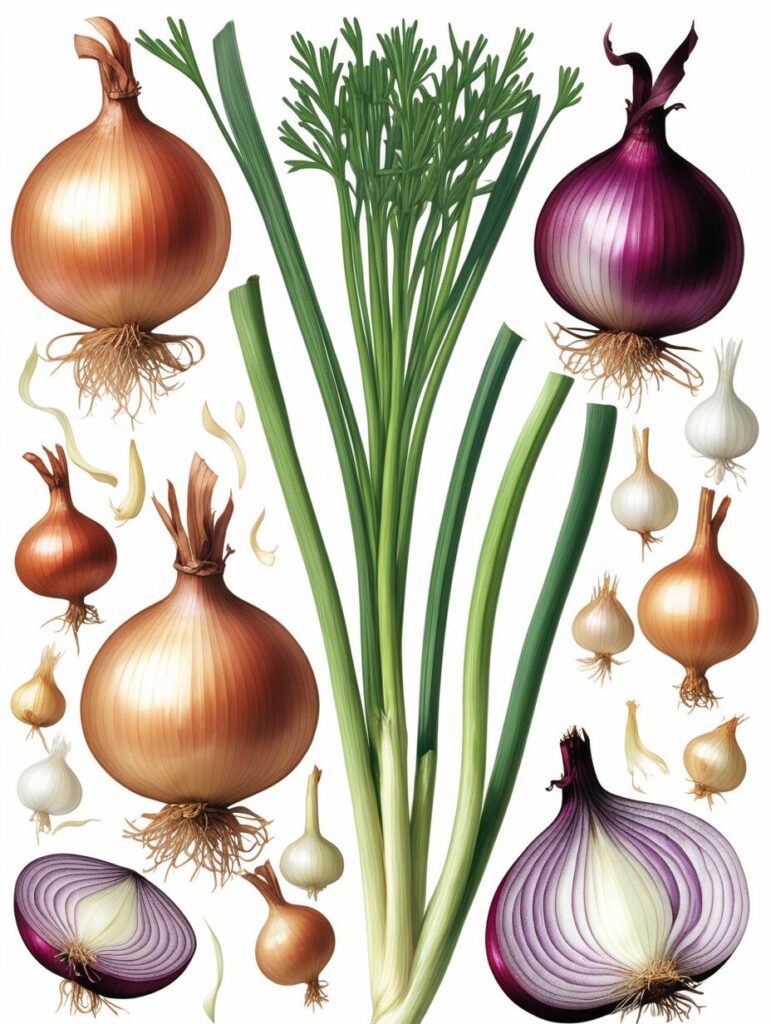The onion, with its robust and multifaceted personality, stands as one of the most esteemed members of the vegetable kingdom. Often touted as the masculine counterpart to its more delicate relatives like garlic and leeks, the onion’s strength and resilience are evident in its ability to thrive in diverse environments. From the fertile soil of cultivated gardens to the harsher conditions of wild landscapes, the onion’s adaptability speaks to its historic prominence and valued status.



Tracing back to the dawn of human consciousness, onions have been part of our journey long before modern civilization. As ancient nomads traversed the land, they must have stumbled upon wild onion bulbs. Recognizing their edible nature was only the beginning; these bulbs were robust crops that could endure varying climates and long treks with these travelers. Onions added flavor to otherwise bland meals, and importantly, they stored well, becoming crucial components for the uncertain life of early explorers.
As civilizations grew, onions made their way to the fertile banks of the Nile. Here, the Egyptians were captivated not only by their flavor but by their structure—a symbolic and sacred geometry that mirrored the eternal nature of their mighty pyramids. Onions became a staple in the diet of those constructing these colossal edifices and were even considered worthy of burial, accompanying pharaohs into the afterlife. Onions adorned altars during solemn ceremonies, offerings layered so they might bestow their symbolism of eternity and immortality upon the divine figures they honored.
Onions’ influence traveled with the seafaring Phoenicians, those business titans of the ancient world. As traders traversing Mediterranean waters, they were instrumental in further spreading onions. The bulbous vegetable found its way to Greek athletes, who consumed them with gusto, under the belief that a belly full of onions would confer victory. The notion of strength and endurance was as embedded into the onion as its layers. Roman soldiers carried them as well across the vast stretches of the empire, inadvertently sowing onions along their routes throughout Europe where they flourished.
With the turn of the Middle Ages, onions served yet another role—as a rumored preventative against diseases and among the most trusted items in a healer’s arsenal. Through trade and exploration, these robust bulbs crossed oceans on the grand vessels of the Age of Discovery, ensuring their place in the New World and beyond. The onion had woven itself indelibly into the tapestry of human culture and cuisine, transforming from an accidental edible to a culinary and cultural artifact.
Onions’ tenacity is mirrored in their adaptability. They can grow virtually anywhere, though they may not always thrive equally well in compacted soils. Their hardy nature embodies masculinity through perseverance and resourcefulness. Yet onions offer more than culinary complement—they offer protection against pests through their pungent aroma, which serves as a powerful deterrent. This defense mechanism exemplifies a protective characteristic, safeguarding both the onion and its surrounding environment, a quintessentially masculine trait.
The tear-inducing experience of slicing onions is well-known—a curious interplay of emotional and physical responses. The onion’s ability to evoke tears blurs traditional notions of gender traits, as crying is often associated with femininity. Yet, within the plant world, these distinctions do not strictly apply. The lachrymatory factor syn-propanethial-S-oxide (SPSO), released when onions are cut, acts as a natural defense against pests, proving both potent and protective. This chemical reaction not only serves to communicate the onion’s presence; it embodies resilience.
These familiar tears are a byproduct of sulfur compounds released when onion cells are sliced. These compounds convert to sulfuric acid upon contact with the moisture in our eyes, triggering the trigeminal nerve, responsible for facial sensations, and provoking tear production to protect sensitive tissues. This natural defense mechanism serves an additional purpose of promoting nasal and sinus health, triggering increased mucus production which helps clear airways and alleviates congestion.
My earliest memories are intertwined with the comforting aroma of onions cooking—a scent that wafted through the air, signaling the promise of a delicious meal. In almost every culture, the smell of onions frying serves as a universal culinary cue. As onions cook, the initial sharpness transforms into a sweet, alluring aroma, thanks to sulfur compounds like thiosulfates and pyruvate. During cooking, thiosulfates break down and interact with pyruvate—a sugar derivative—creating furfurals, compounds that carry a rich, caramelized scent.
This tantalizing transformation is not merely chemical; it is also emotional. The smell of onions evokes responses ranging from delight to aversion, often based on cultural familiarity and personal preference. Caramelization, a reaction at high temperatures, further enhances the aroma with sweet, nutty notes, making cooked onions invitingly palatable and exceedingly versatile.
Historically, onions have held multifaceted roles beyond the culinary. Ancient Egyptians revered them enough to trade them like sacred currency. Throughout different cultures and epochs, onions symbolized more than sustenance; they embodied resilience, healing, and even glamour. From predicting weather patterns in English folklore to serving as talismans against evil during epidemics, onions have been central in human perception of both health and superstition.
Onion medicine is equally storied. Onions, rich in organosulfur compounds, have been linked to congestion relief and antimicrobial benefits. While science continues to explore these mechanisms, organosulfur compounds like thiosulfonates are recognized for antiseptic properties. Similarly, quercetin, a potent flavonoid in onions, holds anti-inflammatory and antioxidant attributes, showing promise against inflammation and cardiovascular issues. Its role extends to supporting liver functions and possibly inhibiting cancerous growth, highlighting onions’ therapeutic potential.
The chemical allure of onions goes deeper. Laden with attributes like pungency, earthiness, and sweetness, onions invigorate our sensory and physiological systems. They engage our bodies in heart health, respiratory care, and immune support. By reducing inflammation and potentially preventing carcinomas, onions contribute significantly to wellness narratives rooted both in folklore and clinical research.
Ayurvedic doshic interpretation presents onions as strongly influencing Kapha dosha, bringing stability and moisture but necessitating moderation to prevent imbalance. Yet, onions’ versatile foliage and pungent personality proclaim an age-old complexity—capturing depth, strength, and transformative potential. Onion-like resilience echoes strength amid the hardships of diverse environments.
Onions are a versatile addition to any garden, accepting cultivation from seed or sets (young plants or bulbs). They can thrive in ample sunlight and well-drained soil rich with organic matter. Onions require consistent, but moderate watering, requiring only minimal protection against excessive heat to keep their roots cool. Harvesting can yield bulbs or greens for varied culinary use, marking onion sections to maintain insect deterrence and cultural integration.
Postbiotically powerful, onions bolster gut health with short-chain fatty acids (SCFAs)—protecting against various forms of chronic inflammation and associated risks like colon cancer. These postbiotics strengthen gut barrier integrity and promote anti-inflammatory immune responses, reflecting onions as a vital tool in nutritional gut health. The non-digestible fibers in onions serve as prebiotic feast for beneficial microbiota, enhancing overall digestive wellness and immunity.
Onions have shaped not just the health landscape but emotional ones too, through their skin-deep symbolism and layered mystique. These humble bulbs reveal depth—of flavor, history, and beneficial compounds—that continuously affirm their revered status across cultures.
A simple recipe like onion syrup provides both nourishment and tradition. This preparation combines the healthful properties of onions with soothing herbal elements like ginger and honey to craft a potent remedy for coughs and colds.
Onion Syrup for Cough and Cold Relief:
- 1 large onion
- 2-3 tbsps of honey or maple syrup
- 1 cup of water
- Optional: lemon juice or ginger (for added flavor)
- Peel and roughly chop the onion. In a small saucepan, add the onion, water, and any optional ingredients.
- Bring the mixture to a boil over medium heat, reduce the heat and let it simmer for about 15-20 minutes until the onion is soft and translucent.
- Remove the saucepan from heat and let it cool slightly. Strain using a fine-mesh strainer or cheesecloth, pressing on the onion to extract as much liquid as possible.
- Allow the liquid to cool completely, then stir in honey or maple syrup to taste.
- Store the onion syrup in a glass jar or bottle in the refrigerator for up to 1 week. Dose: 1-2 tsps as needed to ease coughs and soothe sore throats.
Whether employed as a culinary enhancer, a health tonic, or a cultural symbol, the onion remains a testament to the layered complexity of nature’s provisions and human ingenuity. Its profound effect on taste and health continues to inspire and redefine the landscape of food and medicine, ensuring its place as an indispensable gem of the culinary and health worlds.




